Lianyu Wang
A Clinician-Friendly Platform for Ophthalmic Image Analysis Without Technical Barriers
Apr 22, 2025Abstract:Artificial intelligence (AI) shows remarkable potential in medical imaging diagnostics, but current models typically require retraining when deployed across different clinical centers, limiting their widespread adoption. We introduce GlobeReady, a clinician-friendly AI platform that enables ocular disease diagnosis without retraining/fine-tuning or technical expertise. GlobeReady achieves high accuracy across imaging modalities: 93.9-98.5% for an 11-category fundus photo dataset and 87.2-92.7% for a 15-category OCT dataset. Through training-free local feature augmentation, it addresses domain shifts across centers and populations, reaching an average accuracy of 88.9% across five centers in China, 86.3% in Vietnam, and 90.2% in the UK. The built-in confidence-quantifiable diagnostic approach further boosted accuracy to 94.9-99.4% (fundus) and 88.2-96.2% (OCT), while identifying out-of-distribution cases at 86.3% (49 CFP categories) and 90.6% (13 OCT categories). Clinicians from multiple countries rated GlobeReady highly (average 4.6 out of 5) for its usability and clinical relevance. These results demonstrate GlobeReady's robust, scalable diagnostic capability and potential to support ophthalmic care without technical barriers.
Vision-Language Model IP Protection via Prompt-based Learning
Mar 04, 2025Abstract:Vision-language models (VLMs) like CLIP (Contrastive Language-Image Pre-Training) have seen remarkable success in visual recognition, highlighting the increasing need to safeguard the intellectual property (IP) of well-trained models. Effective IP protection extends beyond ensuring authorized usage; it also necessitates restricting model deployment to authorized data domains, particularly when the model is fine-tuned for specific target domains. However, current IP protection methods often rely solely on the visual backbone, which may lack sufficient semantic richness. To bridge this gap, we introduce IP-CLIP, a lightweight IP protection strategy tailored to CLIP, employing a prompt-based learning approach. By leveraging the frozen visual backbone of CLIP, we extract both image style and content information, incorporating them into the learning of IP prompt. This strategy acts as a robust barrier, effectively preventing the unauthorized transfer of features from authorized domains to unauthorized ones. Additionally, we propose a style-enhancement branch that constructs feature banks for both authorized and unauthorized domains. This branch integrates self-enhanced and cross-domain features, further strengthening IP-CLIP's capability to block features from unauthorized domains. Finally, we present new three metrics designed to better balance the performance degradation of authorized and unauthorized domains. Comprehensive experiments in various scenarios demonstrate its promising potential for application in IP protection tasks for VLMs.
Say No to Freeloader: Protecting Intellectual Property of Your Deep Model
Aug 27, 2024



Abstract:Model intellectual property (IP) protection has attracted growing attention as science and technology advancements stem from human intellectual labor and computational expenses. Ensuring IP safety for trainers and owners is of utmost importance, particularly in domains where ownership verification and applicability authorization are required. A notable approach to safeguarding model IP involves proactively preventing the use of well-trained models of authorized domains from unauthorized domains. In this paper, we introduce a novel Compact Un-transferable Pyramid Isolation Domain (CUPI-Domain) which serves as a barrier against illegal transfers from authorized to unauthorized domains. Drawing inspiration from human transitive inference and learning abilities, the CUPI-Domain is designed to obstruct cross-domain transfers by emphasizing the distinctive style features of the authorized domain. This emphasis leads to failure in recognizing irrelevant private style features on unauthorized domains. To this end, we propose novel CUPI-Domain generators, which select features from both authorized and CUPI-Domain as anchors. Then, we fuse the style features and semantic features of these anchors to generate labeled and style-rich CUPI-Domain. Additionally, we design external Domain-Information Memory Banks (DIMB) for storing and updating labeled pyramid features to obtain stable domain class features and domain class-wise style features. Based on the proposed whole method, the novel style and discriminative loss functions are designed to effectively enhance the distinction in style and discriminative features between authorized and unauthorized domains, respectively. Moreover, we provide two solutions for utilizing CUPI-Domain based on whether the unauthorized domain is known: target-specified CUPI-Domain and target-free CUPI-Domain.
Common and Rare Fundus Diseases Identification Using Vision-Language Foundation Model with Knowledge of Over 400 Diseases
Jun 13, 2024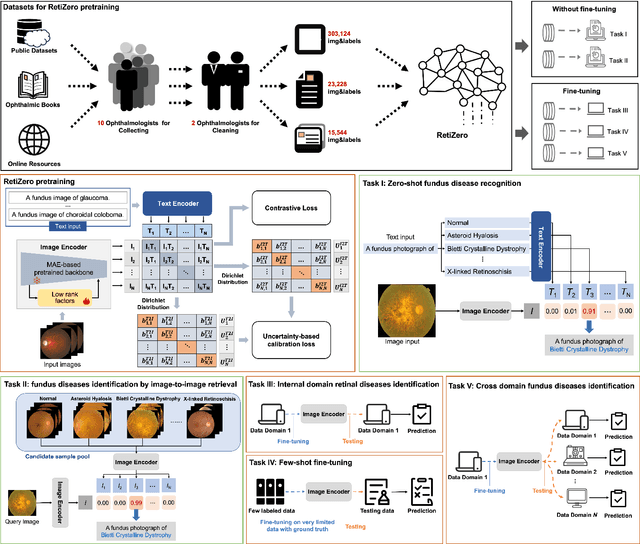
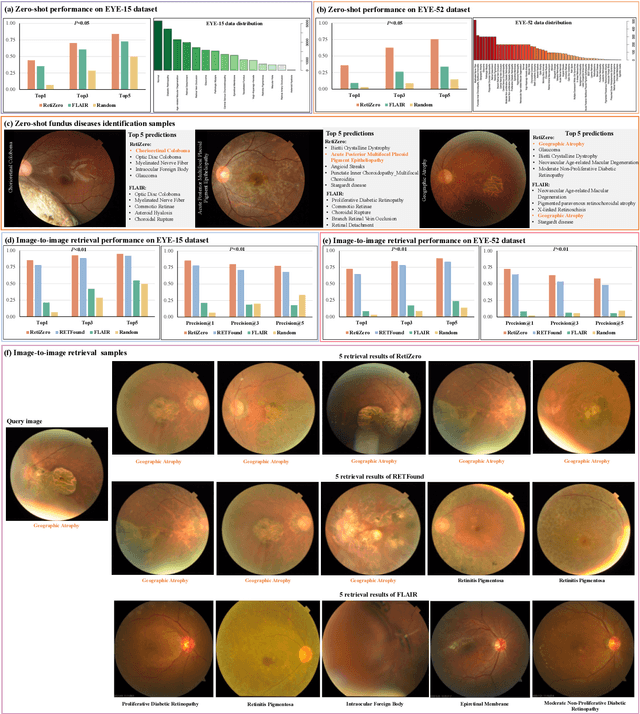
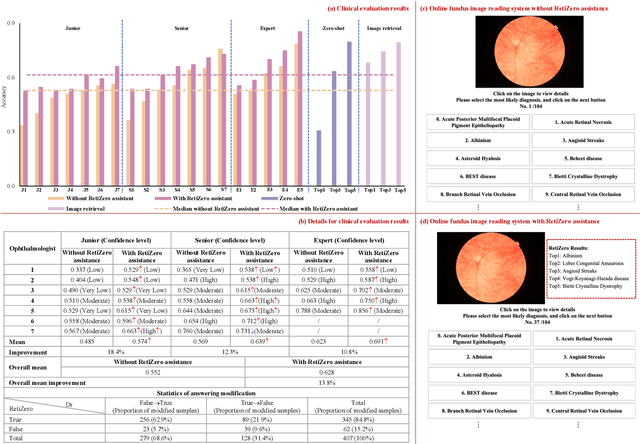
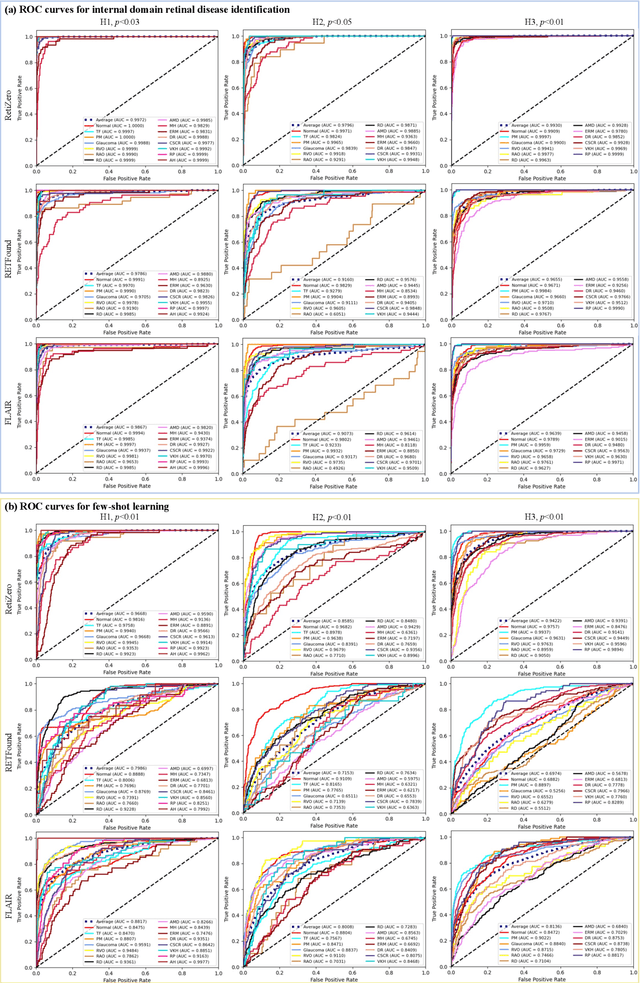
Abstract:The current retinal artificial intelligence models were trained using data with a limited category of diseases and limited knowledge. In this paper, we present a retinal vision-language foundation model (RetiZero) with knowledge of over 400 fundus diseases. Specifically, we collected 341,896 fundus images paired with text descriptions from 29 publicly available datasets, 180 ophthalmic books, and online resources, encompassing over 400 fundus diseases across multiple countries and ethnicities. RetiZero achieved outstanding performance across various downstream tasks, including zero-shot retinal disease recognition, image-to-image retrieval, internal domain and cross-domain retinal disease classification, and few-shot fine-tuning. Specially, in the zero-shot scenario, RetiZero achieved a Top5 score of 0.8430 and 0.7561 on 15 and 52 fundus diseases respectively. In the image-retrieval task, RetiZero achieved a Top5 score of 0.9500 and 0.8860 on 15 and 52 retinal diseases respectively. Furthermore, clinical evaluations by ophthalmology experts from different countries demonstrate that RetiZero can achieve performance comparable to experienced ophthalmologists using zero-shot and image retrieval methods without requiring model retraining. These capabilities of retinal disease identification strengthen our RetiZero foundation model in clinical implementation.
Uncertainty-inspired Open Set Learning for Retinal Anomaly Identification
Apr 08, 2023
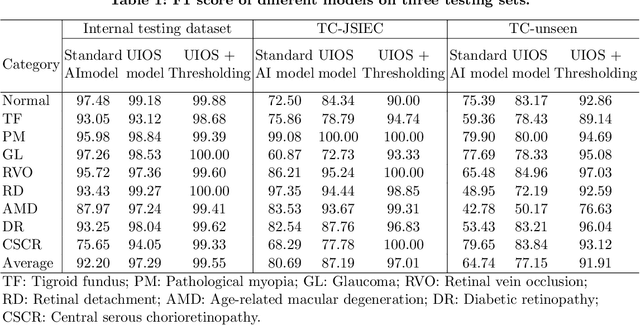


Abstract:Failure to recognize samples from the classes unseen during training is a major limit of artificial intelligence (AI) in real-world implementation of retinal anomaly classification. To resolve this obstacle, we propose an uncertainty-inspired open-set (UIOS) model which was trained with fundus images of 9 common retinal conditions. Besides the probability of each category, UIOS also calculates an uncertainty score to express its confidence. Our UIOS model with thresholding strategy achieved an F1 score of 99.55%, 97.01% and 91.91% for the internal testing set, external testing set and non-typical testing set, respectively, compared to the F1 score of 92.20%, 80.69% and 64.74% by the standard AI model. Furthermore, UIOS correctly predicted high uncertainty scores, which prompted the need for a manual check, in the datasets of rare retinal diseases, low-quality fundus images, and non-fundus images. This work provides a robust method for real-world screening of retinal anomalies.
Federated Uncertainty-Aware Aggregation for Fundus Diabetic Retinopathy Staging
Mar 23, 2023Abstract:Deep learning models have shown promising performance in the field of diabetic retinopathy (DR) staging. However, collaboratively training a DR staging model across multiple institutions remains a challenge due to non-iid data, client reliability, and confidence evaluation of the prediction. To address these issues, we propose a novel federated uncertainty-aware aggregation paradigm (FedUAA), which considers the reliability of each client and produces a confidence estimation for the DR staging. In our FedUAA, an aggregated encoder is shared by all clients for learning a global representation of fundus images, while a novel temperature-warmed uncertainty head (TWEU) is utilized for each client for local personalized staging criteria. Our TWEU employs an evidential deep layer to produce the uncertainty score with the DR staging results for client reliability evaluation. Furthermore, we developed a novel uncertainty-aware weighting module (UAW) to dynamically adjust the weights of model aggregation based on the uncertainty score distribution of each client. In our experiments, we collect five publicly available datasets from different institutions to conduct a dataset for federated DR staging to satisfy the real non-iid condition. The experimental results demonstrate that our FedUAA achieves better DR staging performance with higher reliability compared to other federated learning methods. Our proposed FedUAA paradigm effectively addresses the challenges of collaboratively training DR staging models across multiple institutions, and provides a robust and reliable solution for the deployment of DR diagnosis models in real-world clinical scenarios.
Model Barrier: A Compact Un-Transferable Isolation Domain for Model Intellectual Property Protection
Mar 20, 2023Abstract:As scientific and technological advancements result from human intellectual labor and computational costs, protecting model intellectual property (IP) has become increasingly important to encourage model creators and owners. Model IP protection involves preventing the use of well-trained models on unauthorized domains. To address this issue, we propose a novel approach called Compact Un-Transferable Isolation Domain (CUTI-domain), which acts as a barrier to block illegal transfers from authorized to unauthorized domains. Specifically, CUTI-domain blocks cross-domain transfers by highlighting the private style features of the authorized domain, leading to recognition failure on unauthorized domains with irrelevant private style features. Moreover, we provide two solutions for using CUTI-domain depending on whether the unauthorized domain is known or not: target-specified CUTI-domain and target-free CUTI-domain. Our comprehensive experimental results on four digit datasets, CIFAR10 & STL10, and VisDA-2017 dataset demonstrate that CUTI-domain can be easily implemented as a plug-and-play module with different backbones, providing an efficient solution for model IP protection.
TrFedDis: Trusted Federated Disentangling Network for Non-IID Domain Feature
Jan 30, 2023



Abstract:Federated learning (FL), as an effective decentralized distributed learning approach, enables multiple institutions to jointly train a model without sharing their local data. However, the domain feature shift caused by different acquisition devices/clients substantially degrades the performance of the FL model. Furthermore, most existing FL approaches aim to improve accuracy without considering reliability (e.g., confidence or uncertainty). The predictions are thus unreliable when deployed in safety-critical applications. Therefore, aiming at improving the performance of FL in non-Domain feature issues while enabling the model more reliable. In this paper, we propose a novel trusted federated disentangling network, termed TrFedDis, which utilizes feature disentangling to enable the ability to capture the global domain-invariant cross-client representation and preserve local client-specific feature learning. Meanwhile, to effectively integrate the decoupled features, an uncertainty-aware decision fusion is also introduced to guide the network for dynamically integrating the decoupled features at the evidence level, while producing a reliable prediction with an estimated uncertainty. To the best of our knowledge, our proposed TrFedDis is the first work to develop an FL approach based on evidential uncertainty combined with feature disentangling, which enhances the performance and reliability of FL in non-IID domain features. Extensive experimental results show that our proposed TrFedDis provides outstanding performance with a high degree of reliability as compared to other state-of-the-art FL approaches.
Unsupervised Domain Adaptation via Style-Aware Self-intermediate Domain
Sep 05, 2022
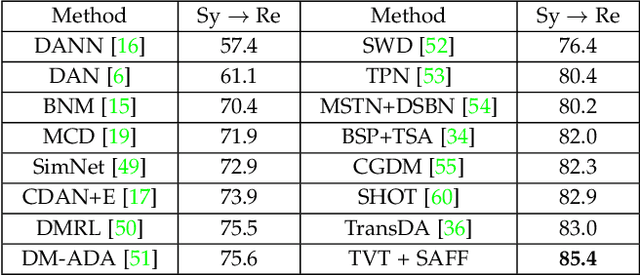

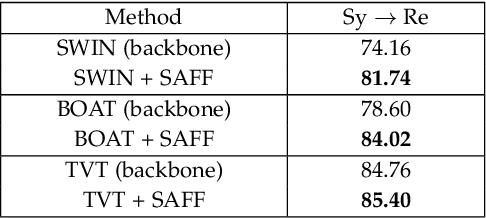
Abstract:Unsupervised domain adaptation (UDA) has attracted considerable attention, which transfers knowledge from a label-rich source domain to a related but unlabeled target domain. Reducing inter-domain differences has always been a crucial factor to improve performance in UDA, especially for tasks where there is a large gap between source and target domains. To this end, we propose a novel style-aware feature fusion method (SAFF) to bridge the large domain gap and transfer knowledge while alleviating the loss of class-discriminative information. Inspired by the human transitive inference and learning ability, a novel style-aware self-intermediate domain (SSID) is investigated to link two seemingly unrelated concepts through a series of intermediate auxiliary synthesized concepts. Specifically, we propose a novel learning strategy of SSID, which selects samples from both source and target domains as anchors, and then randomly fuses the object and style features of these anchors to generate labeled and style-rich intermediate auxiliary features for knowledge transfer. Moreover, we design an external memory bank to store and update specified labeled features to obtain stable class features and class-wise style features. Based on the proposed memory bank, the intra- and inter-domain loss functions are designed to improve the class recognition ability and feature compatibility, respectively. Meanwhile, we simulate the rich latent feature space of SSID by infinite sampling and the convergence of the loss function by mathematical theory. Finally, we conduct comprehensive experiments on commonly used domain adaptive benchmarks to evaluate the proposed SAFF, and the experimental results show that the proposed SAFF can be easily combined with different backbone networks and obtain better performance as a plug-in-plug-out module.
 Add to Chrome
Add to Chrome Add to Firefox
Add to Firefox Add to Edge
Add to Edge